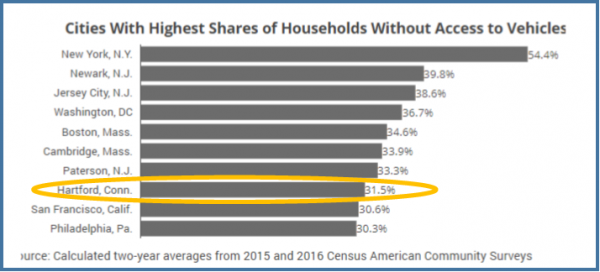Hartford, New Haven See Diminishing Car Ownership Among Households; Hartford Ranks 8th in U.S. in Percentage Without Cars
/Owning a car isn’t what it used to be – at least it isn’t as necessary as it used to be. Demographics, fuel prices and where people live also play a role in whether a household goes car-free, according to a recent analysis by Governing magazine. Research also suggests younger families and one-person households are more likely to not own a car.
The publication reports that several mid-sized cities recorded notable increases in shares of car-free households when averages from the 2015 and 2016 American Community Surveys are compared with those for 2009 and 2010. Those cities include New Haven.
According to the Census Bureau estimates, only 8.7 percent of U.S. households reported not having any vehicles available in 2016, about the same level as before the Great Recession.
In New Haven, the trend is stronger. About 30 percent of New Haven households are without access to vehicles, an increase from about 27 percent in 2009-2010, Governing points out. Part of the reason so many residents can go car-free stems from the city’s fairly residential downtown and pedestrian-friendly street grid layout, the publication explains, adding that New Haven’s high poverty rate is also a likely contributing factor, with many families unable to afford cars.
Other cities earning a spot on the list of for rapidly dropping car ownership are Paterson, N.J.; Davenport, Iowa; Elizabeth, N.J.; and Peoria, Ill.
 Hartford has a presence in the top 10 cities that already have among the highest share of households without a car, at a 31.5 percent two-year average. Hartford ranks 8th. The list is led by New York City at 54.4 percent, with Newark, Jersey City, Washington, Boston, Cambridge and Paterson in between. San Francisco and Philadelphia round out the top 10 after Hartford. Hartford increased from 30.3% in 2015 to 32.6% in 2016.
Hartford has a presence in the top 10 cities that already have among the highest share of households without a car, at a 31.5 percent two-year average. Hartford ranks 8th. The list is led by New York City at 54.4 percent, with Newark, Jersey City, Washington, Boston, Cambridge and Paterson in between. San Francisco and Philadelphia round out the top 10 after Hartford. Hartford increased from 30.3% in 2015 to 32.6% in 2016.
Among other Connecticut cities, Stamford’s households without vehicles is at 10 percent; Waterbury at 20.5 percent; and Bridgeport at 21.1 percent.
Data was calculated using two-year averages from 2015 and 2016 Census survey estimates.





























